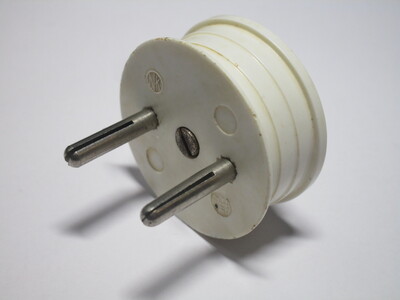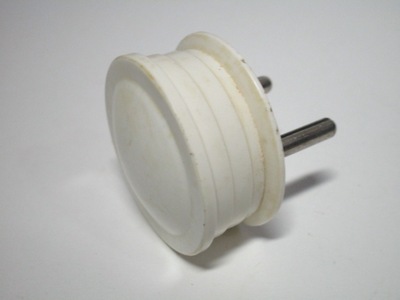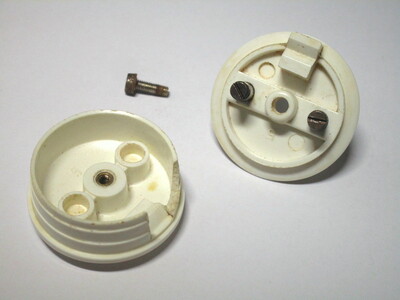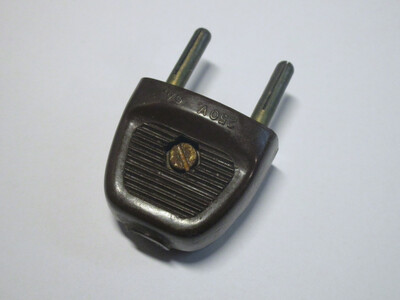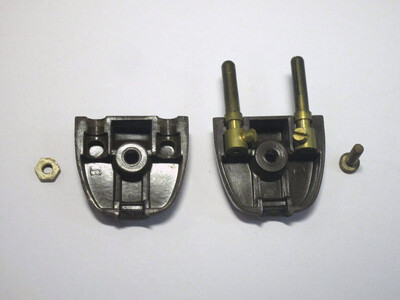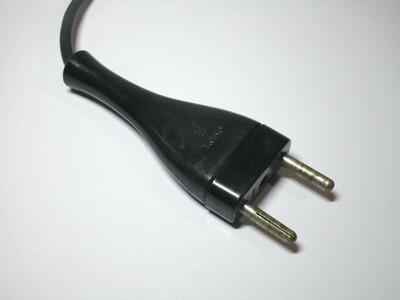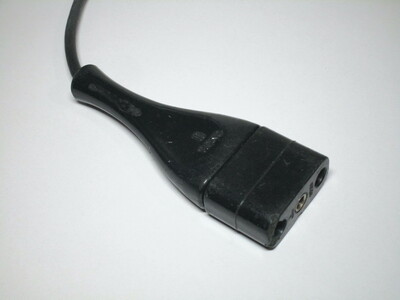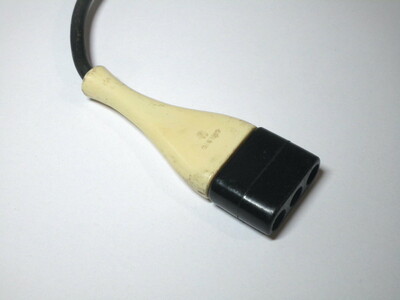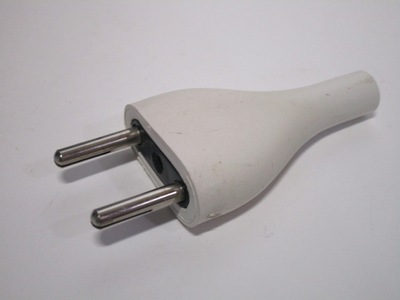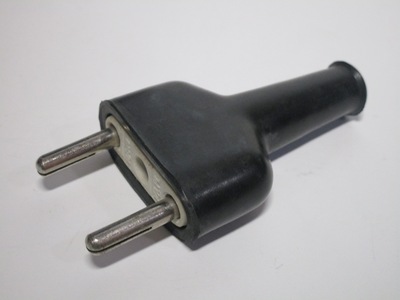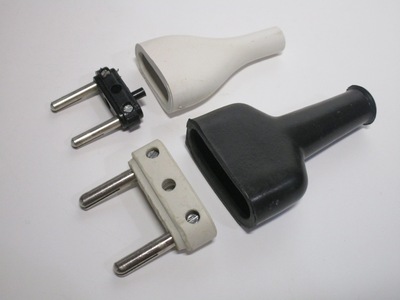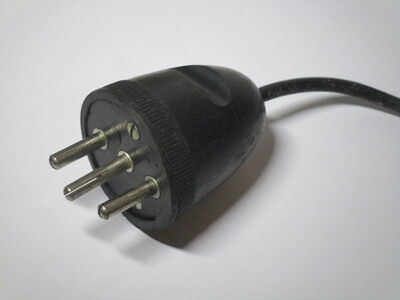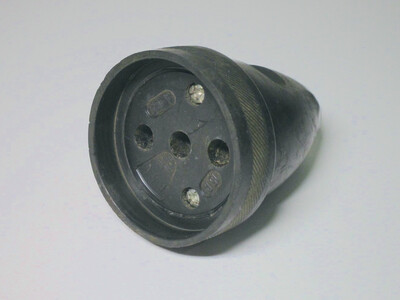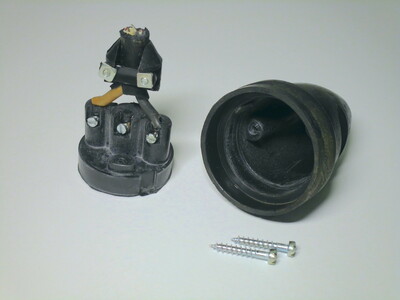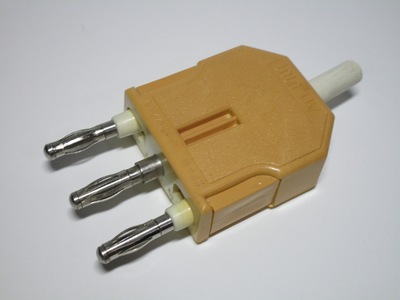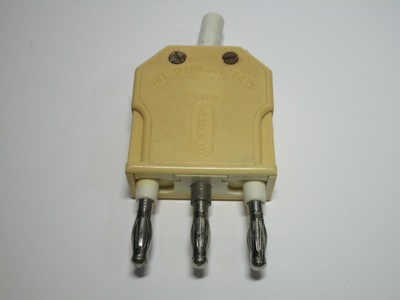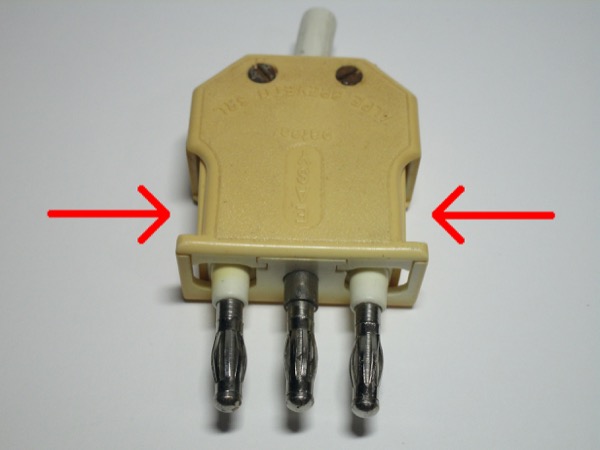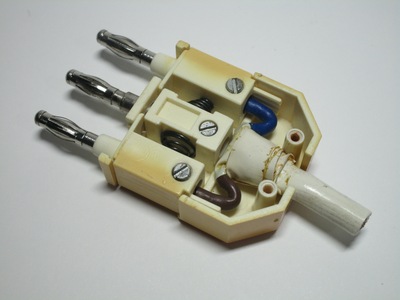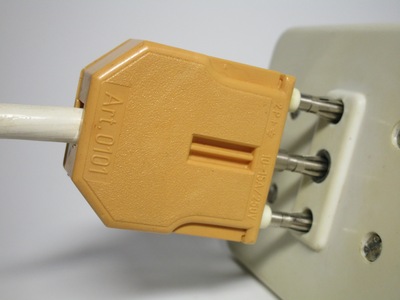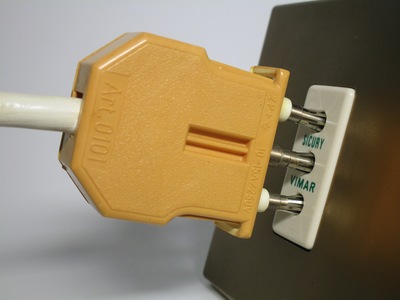Vintage Italian plugs
All across the world plugs have evolved significantly over time, changing to suit the design standards of the time and improving in safety. Italy is certainly no exception: plug designs there have varied considerably over time, more so than most other European countries.
As discussed in more detail in the Italian electrical history page, Italy uses the type L plug standard which comes in two different sizes, a 10A one and a 16A (formerly 15A) one. These two standards were once mutually incompatible and were originally meant to run at different voltages, 120V for lighting and 220V for heavy appliances. While the country later unified to 220V, the differing standards remained.
Note that this page is only for household plugs, connector sockets (typically found on extension cords) and adaptors. Power sockets are featured in their own dedicated page, as are vintage industrial plugs.
Small 2-pin plug
Rating: unknown
This extremely small plug, found attached to a tube radio, is a typical example of plugs used in the early days of electricity. Its diminutive design makes it easy to accidentially touch the pins while plugging it into a socket.
As the plug is made out of a single piece of bakelite, wiring it is done by unscrewing the pins - which have a threaded base - and wrapping the wire around them, which is then held in place with a washer.
Bakelite plug
Rating: 6A 250V
This plug, roughly contemporary to the previous one, is smaller and has a more similar page to modern ones. It's made out of two identical pieces of brown bakelite which are held together with a screw and nut - a clever solution to avoid having to manufacture two different mouldings.
While smaller plugs were certainly handy in a household environment, they were considerably less safe as it was much easier to accidentally touch the live pins while unplugging it.
Round 15A plug
Rating: 15A 250V
Early on, 15A plugs were largely relegated to heavy appliances - which there were few of at home - and workshops, as well as light industrial use. As a result, they tended to be bulkier and less household-friendly.
The model shown here, made of bakelite, is a good example of one of these old 15A plugs. As is typical for these early models, it features a large round body and a very utilitarian design, without any decorations. Even after smaller versions were available, round 15A plugs continued to be sold until the 60s/70s as ruggedised models, usually made of an impact-resistant material.
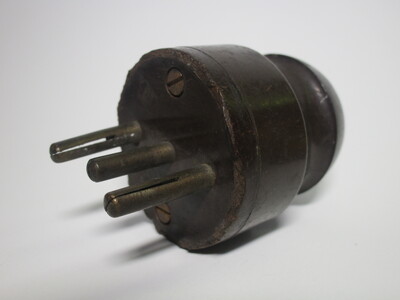
BTicino plug and connector sockets
Rating: 15A 250V (large plug and socket only)
As materials improved and designs shifted, so too did the shape of electrical items such as plugs. This is rather evident in these models from BTicino, whose design and size are much different from older versions.
The plug is a 15A non-earthed type, obviously too old to have sleeved pins, though this design was sold for long enough that later editions did feature them. Wiring it is done though a quite unusual method: the pins of the plug can be unscrewed by hand by twisting them, then the front plastic piece drops out and the wires can be arranged in a circular shape to make contact with the pins.
Except for their size, the two connector sockets - of the "large" and "small" type - are essentially identical. They're too old to have shutters, and their slim design makes it possible to hook up a plug in dangerous configurations, such as connecting the earth pin of an appliance into one of the live conductors. Their internal contacts are also very close to the exterior surface; while this may help secure a better connection, it also means that it's possible to plug in an unsleeved plug half way and leave a considerable amount of metal exposed and easy to touch.
Wiring them is as strange as with the plug: you have to insert a screwdriver into the internal contacts, which have a slot for this purpose, and unscrew them. Then they can be removed and the wire is connected as with the plug from earlier, by twisting the wire around and placing it around the threads of the contacts.
Rubber-bodied plugs
Rating: 10A 250V and 15A 380V
These are two plugs built in a similar way, with a flexible rubber body and a hard plastic (or ceramic, for the larger plug) base to hold the pins and screw connections. Notably, on both of them a hole is present for a possible earth pin, which isn't there in either of the plugs.
To wire them up, the pins are bent sideways to force the base piece out of the rubber body. This can be tricky to do, though that's good since it means it'd be difficult for the plug to come apart while in use, and thus revealing live connections.
Interestingly, while the smaller plug has the usual rating of 10A 250V, the larger one is rated for 380V - this is quite odd as that style of socket was generally always used for 220V (or, rarely, similar voltages such as 260V). This rating indicates the possibility of using this with two phases of a 220/380V transformer, a quite unusual setup.
Round 15A plug and socket
Rating: 15A 250V and 15A 380V
These two items, made by OVA, were found at the end of some old extension cords. As was common for these ruggedised plug designs, they're both made of a somewhat flexible rubbery material with a quite large shape, being completely round at the front, which makes them take up more space compared to standard plug designs.
The plug is rather unusual as it has a longer earth pin; this is a fairly common feature on other standards of plug, to ensure that the earth is always connected first, but it's not at all a thing on Italian plugs. It's more common to have the socket use a slightly raised earth contact for essentially the same purpose.
The socket has dimensions similar to the round plug previously mentioned. It has a small indentation on the outside, presumably to help reduce the risk of accidental contacts; while this wouldn't help completely, especially with smaller plugs, it's better than nothing.
Dual-use plug (fits in either type of socket)
Rating: 10/15A 250V
This very unusual plug has been designed specifically to fit in both 10A and (non-Bipasso) 16A power sockets. It's normally held in the 16A position with springs, however, when the two levers on the sides are pushed inwards the pins move closer together to fit 10A sockets.
The shape of the pins is quite unusual, too, resembling "banana plugs" used in electronics projects. This was possibly chosen so that they would both be thin enough to fit in 10A socket contacts while also making a good connection for 16A ones. However, it does put into question its claimed rating, as there's no way that these could safely handle 15A.
Once opened up, the plug is identical to standard ones, albeit with the aforementioned springs which move the pins back into the 16A position when the two side levers aren't pushed in.
Dual-use plugs like this one did not catch on and were very uncommon; the problem of the two incompatible standards was instead moved to the socket end, with the now ubiquitous Bipasso outlets being made to fit both styles of plug in use in Italy.
